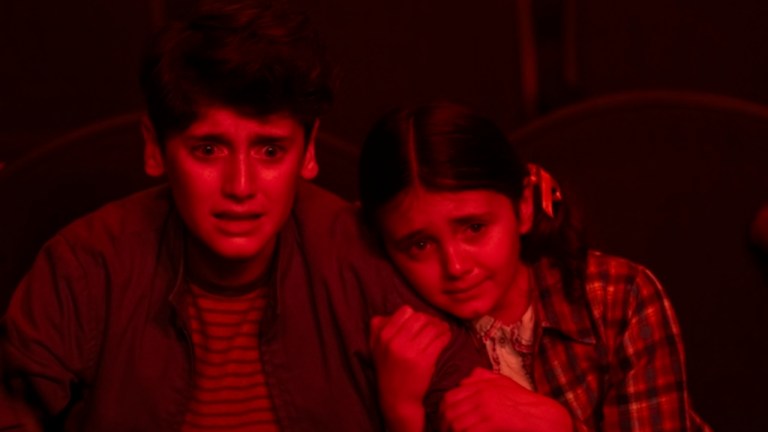Horror’s Greatest Taboo Isn’t Taboo If Everyone’s Doing It
Killing a child on screen used to be shocking. Now it's just dull.

This article contains spoilers for Terrifier 3, V/H/S/Halloween, and It: Welcome to Derry.
It took John Carpenter just over 30 minutes to kill a kid. In his 1976 movie Assault on Precinct 13, a cute lil’ moppet with blonde pigtails wanders back to the ice cream truck that just sold her a cone, not realizing that the vendor has been murdered by street toughs. As soon as she arrives, one of those toughs blasts her without a second thought, splatting blood across her overalls.
Shocking as the moment was to audiences 50 years ago, little Kathy’s (Kim Richards) death has nothing on the carnage that finishes the premiere of the HBO Max series It: Welcome to Derry. In the final scene, the show’s titular Eldritch terror hijacks a screening of The Music Man to launch an attack on a quintet of youngsters. First, it takes the form a kid It killed earlier to appear on screen and accuse his friends of failing him. Then, It jumps out of the screen in the form of a fetus with batwings, and all manner of gratuitous mayhem follows. Preteens are torn in two and their bloody bodies tossed around, building to a moment in which older girl Lilly (Clara Stack) thinks she’s pulled younger child from the maelstrom, only to realize that she’s clutching the tot’s severed arm.
The sequence is in no way scary. As he did in both of his It movies, director Andy Muschietti relies on music stings and shaky monsters charging the camera, tricks that fail to surprise even novice horror watchers. However, one gets the sense that Muschietti isn’t trying to scare the viewers as much as disturb them, shock them with his boundary-pushing just like Carpenter before him.
Yet, even in that regard, Muschietti fails, precisely because killing kids isn’t taboo anymore. Whether its mainstream bids like It and Stranger Things, or more outré projects like V/H/S/Halloween and the Terrifier series, kid-killing is in. Worse, it’s boring.
A Well-Trod Transgression
Carpenter orchestrated the death of Kathy to both shock the viewers and establish the moral order of his universe. Drawing on Night of the Living Dead and Westerns such as Fort Apache, which depicted Indigenous peoples as non-human savages to whom reason does not apply, Carpenter wanted to establish in the audience’s mind that the essentially ghouls would be laying siege to the titular precinct. And even then, Carpenter later expressed regret about the scene, calling himself “young and stupid” at the time.
Carpenter certainly wasn’t the first person to threaten a kid on screen. Fritz Lang’s 1931 mystery M focused on the search for a child killer, and the 1955 Charles Laughton film The Night of the Hunter was driven by the threat that drifter Harry Powell (Robert Mitchum) would kill the kids living in the boarding house with him. But neither of these movies were explicit in their depictions, and realized the weight of what they were doing, as did Carpenter. Perversely, the same is true of exploitation films of the 1970s and ’80s that pushed buttons by killing children. When teens repeatedly drive over a young bike rider in The Toxic Avenger (1984) or a posse opens fire on a group of tots in Beware! Children at Play (1989), one can almost hear Troma founder Lloyd Kaufman giggling in glee.
That same giggle echoes in modern kid-killing movies. Despite their over-abundance of lore, the Terrifier films exist as little more than sizzle reels for (really impressive) gore effects, which creator Damien Leone deploys in sadistic set-pieces. There’s an unearned self-satisfaction to the moment in Terrifier 3 when the Christmas-themed sequel has Art dress up as Santa and start handing out “toys,” and the movie even teases the audience, making them think that the tots will actually survive the encounter before finally blowing them up, and sprinkling kid parts across the screen.
It’s not scary. It isn’t even shocking, because the movie knows we’re expecting it. After watching Georgie get massacred in It and seeing the kids from Hawkins get hunted by Vecna on Stranger Things, we’re used to thinking about childhood coming to a horrible end.
A Tool Becomes a Crutch
No film illustrates the problem with this tired taboo better than V/H/S/Halloween, the latest entry in the long-running anthology series. Despite gathering names such as Alex Ross Perry (Listen Up Phillip, Her Smell), Casper Kelly (“Too Many Cooks”) and Paco Plaza (REC), Halloween is perhaps the weakest V/H/S film precisely because it relies too much on the shock of killing kids.
The wrap-around segment “Diet Fantasma” by Bryan M. Ferguson features executives at a soda facility sacrificing children who perform taste tests on their latest drink, complete with a scene of a youngster popping like a balloon after taking a sip. In “Coochie Coochie Coo” by Anna Zlokovic, a pair of high schools are infantilized by a monstrous mother, who tortures them while turning them into babies. We see beasties drag away little ones in the last segment “Home Haunt” by Micheline Pitt-Norman & R.H. Norman, while Kelly’s “Fun Size” ends with a boy and a girl being taken away to be cut up into little candies. By the time we get to Perry’s bleak “Kidprint,” in which a Cosby-coded proprieter of a child safety service kidnaps and tortures the kids he photographs, we’re not shocked, we’re not even disgusted.
And that’s the problem with the current trend of kid danger. Certainly, the death of a child can still shock—see the memorable opening of The Witch or the infamous scene from Hereditary. More recently, both Weapons and Black Phone 2 included child endangerment, but did not make them the one idea of their film.
Sure, there’s some gnarly moments when young Gwen (Madeleine McGraw) sees the remains of the Grabber’s (Ethan Hawke) work in Black Phone 2, but director Scott Derrickson uses the sight of the victims as just one element of a scene. The images of dead children combine with grainy Super 8 footage, an atonal score, and strong performances to make the moment scary. Likewise, Weapons implies something terrible has happened to the children who all run out of their neighborhood homes early one morning. But for most of the movie, their actual fate is held off screen, letting us spend time with the various adults who try to make sense of the tragedy.
As Assault on Precinct 13 showed, killing a child on screen can be upsetting and revolting. But as Terrifier 3, V/H/S/Halloween, and Welcome to Derry illustrate, it can be something so much worse. Killing a kid can be boring.
